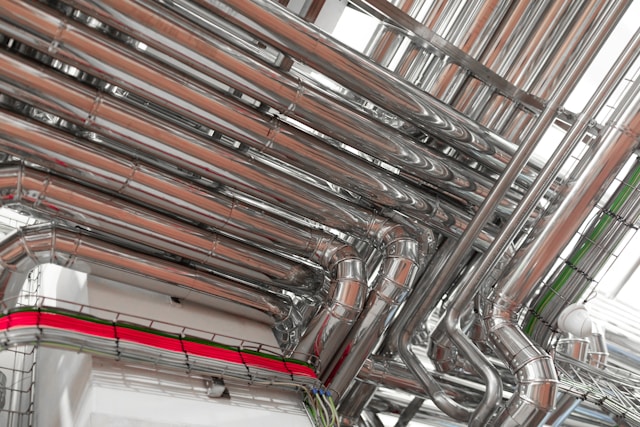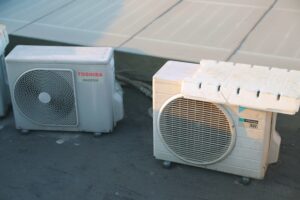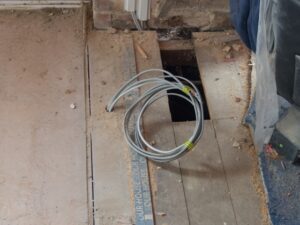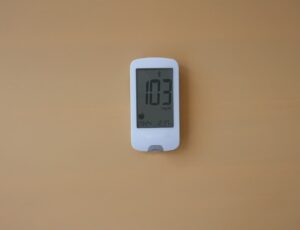Looking to improve your home or office environment?
Sometimes, a simple retrofit is all it takes to boost comfort and efficiency.
Upgrading your HVAC system can make a world of difference, not only in terms of energy savings but also in the quality of your indoor air and overall comfort. Imagine no more uneven heating or cooling, just a perfectly balanced indoor climate that suits your needs.
But where do you start?
Well, it’s all about making the right upgrades.
The good news?
Retrofits can offer a cost-effective solution without the need for a complete system overhaul. Excel Mechanical is here to guide you through the process, offering expert HVAC and plumbing services that match your specific needs and budget.
When it comes to ensuring optimal performance, you need the right professionals by your side. With years of experience, we are committed to delivering top-quality results. Our team prioritizes your comfort, efficiency, and peace of mind, making your HVAC retrofit experience as seamless and effective as possible.
In this blog, we will cover:
- The basics of HVAC systems and why retrofitting is essential for efficiency
- Key strategies to retrofit your system for maximum comfort and savings
- The long-term benefits of upgrading your HVAC system
Let’s get started!
Fundamentals of HVAC Systems
Understanding HVAC systems helps in achieving greater efficiency and comfort. These systems are vital for controlling the internal environment of buildings through heating, cooling, and ventilation. A well-functioning HVAC system ensures a pleasant atmosphere whether you’re at home or in a commercial space.
Components and Functionality
HVAC systems consist of several parts that work together.
- Furnaces provide heat by burning fuel or using electricity.
- Meanwhile, air conditioners cool the air by removing heat and moisture.
- Ductwork channels air throughout the space and thermostats control temperature settings to ensure comfort.
- Ventilation systems play a crucial role by exchanging indoor and outdoor air. They help maintain air quality by filtering out pollutants.
A system’s design and installation affect its performance.
Energy Consumption Patterns
Energy use in HVAC systems can significantly impact the environment and your bills. Heating usually consumes the most energy, especially in colder months, while cooling demands peak during the summer.
Improving energy efficiency helps reduce costs. Smart thermostats can adapt to your schedule, minimizing waste. Insulation also plays a significant role in maintaining desired temperatures without overburdening the system.
Assessment of Existing HVAC Systems
To improve HVAC systems, it’s crucial to evaluate their current performance and energy efficiency. Quality assessments help identify areas for improvement and guide retrofit decisions.
Performance Analysis
Start by checking the key components of your HVAC system, such as heating, cooling, and ventilation units. Look for signs of inefficiency, such as uneven temperatures, frequent breakdowns, or high energy consumption. Regular inspections help spot these issues early.
A detailed performance analysis may include measuring airflow, checking thermostat accuracy, and testing the system’s response times. Gathering this data helps pinpoint specific problems. Comparison with industry benchmarks can show how well your system performs relative to similar setups.
Using specialized tools and software can give more precise data.
Energy Efficiency Audits
An energy efficiency audit studies how well your HVAC system conserves energy.
The key factors analyzed include energy usage patterns, equipment age, and system load capacity. Get familiar with your utility bills and consider usage trends to uncover inefficiencies.
The audit process involves reviewing insulation, ductwork, and building design. Identifying leaks in ductwork or low-quality insulation can point to straightforward fixes. A comprehensive audit will result in an actionable plan highlighting which upgrades offer the biggest energy savings.
Partnering with a team like ours guarantees support from experts committed to exceptional quality and great value. We determine specific upgrades that align with your home’s or business’s needs while considering your budget constraints.
Strategies for Retrofitting
Improving HVAC systems through retrofitting can boost efficiency, reduce energy costs, and enhance comfort. Key strategies involve upgrading system components, integrating renewable energy sources, and implementing advanced control systems to optimize operations.
Upgrading Components
One of the first steps in retrofitting is upgrading existing components.
This includes replacing outdated parts like compressors or fans with high-efficiency models. High-quality filters can improve air quality and help systems run smoothly. Installing variable speed drives on motors can lead to significant energy savings by adjusting speed based on need.
Consider adding economizers to ventilation systems. These devices can reduce energy use by utilizing outside air for cooling when conditions are favorable. This is particularly beneficial for larger buildings where cooling costs can be substantial.
Integration of Renewable Energy
Incorporating renewable energy is a smart way to enhance system performance.
Solar panels can be installed to supplement traditional energy sources, reducing reliance on non-renewable power. This can lower utility bills and decrease your carbon footprint.
Geo-exchange technology is another option, using the earth’s consistent temperature to aid in heating and cooling. Implementing renewable energy solutions contributes to sustainability efforts and may qualify for financial incentives or rebates, further lowering overall costs.
Advanced Control Systems
Implementing advanced control systems can dramatically improve HVAC performance.
Programmable thermostats allow precise control over temperature settings, adapting to occupancy patterns. This helps in minimizing energy waste when spaces are unoccupied.
Modern building management systems (BMS) integrate HVAC controls into one platform, optimizing energy use across the board. These systems provide real-time data, allowing for prompt troubleshooting and adjustments to maintain efficiency.
Economic Analysis
When considering HVAC retrofits, it is crucial to examine the costs and benefits associated with the upgrade, as well as the expected return on investment. Doing so ensures that the decision is financially sound.
Cost-Benefit Analysis
Analyzing expenses and savings is key to understanding the financial side of HVAC retrofits.
The initial cost often includes equipment, labor, and installation. Over time, the retrofit can reduce energy consumption, lower utility bills, and decrease maintenance expenses.
Identifying potential savings is important. Upgraded systems can offer improved efficiency and reliability. Investing in a retrofit now can lead to significant savings in the long run.
Get professional guidance to make informed financial decisions.
Return on Investment Forecasts
Calculating the return on investment (ROI) gives you a clearer picture of the expected financial benefits over time. Determining the payback period is essential. This period reflects how long it takes for savings to cover the initial costs. Short payback periods often indicate a more favorable investment.
Excel Mechanical offers expert advice on ROI by considering system efficiency and local energy rates. Our professional approach ensures you get the best value for your investment, optimizing both performance and savings.
Choices based on careful ROI predictions help prioritize which retrofits to implement.
Implementation Process
Upgrading your HVAC system involves careful planning, the right choice of contractor, and ensuring adherence to regulations. Each step is crucial for achieving improved performance and energy efficiency.
Project Planning
To start, you need a detailed plan.
Assess your current system, identify areas needing improvement, and set clear goals for the upgrade. Take into account factors like energy efficiency, cost, and long-term maintenance.
Make a checklist of the new system’s needs and preferences. This will help guide decisions and keep the project on track. Outlining a budget and timeline early on is also smart to avoid surprises.
Effective planning reduces disruptions and ensures the retrofit meets your needs and expectations. Implementation runs more smoothly when there’s a solid framework from the beginning.
Contractor Selection
Choosing the right contractor is critical to a successful retrofit.
Look for experienced and qualified professionals who demonstrate expertise in HVAC retrofits. Verify credentials and ask for references to gauge reliability and performance history.
Our team stands out for its exceptional quality and value. With our skilled team, you’ll receive a personalized system tailored to your needs and budget. Transparent communication and great customer service are essential qualities to look for.
Having the right experts ensures high-quality work and peace of mind.
Compliance and Regulations
Ensure the retrofit complies with local and national building codes and regulations. This keeps the project legally sound and can prevent costly corrections later.
Research the necessary permits and certifications. Environmental and energy-efficiency standards should also be addressed. This is important for safety and can lead to long-term energy savings.
Hiring experienced contractors simplifies compliance. Our knowledge of industry standards ensures the project meets all requirements while still focusing on performance and efficiency improvements.
Case Studies and Best Practices
Looking at successful HVAC retrofits and the role of innovative technologies can provide valuable insights. These examples showcase improved energy efficiency and reduced costs.
Successful Retrofits
In one example, an office building underwent a retrofit to upgrade an outdated HVAC system.
The project included installing energy-efficient units and improving insulation. After the retrofit, the building saw a 30% reduction in energy bills. This approach saved money and improved the overall comfort for occupants. Similarly, a school updated its ventilation system, which led to better air quality for students and staff.
When considering HVAC retrofits, choosing a service provider that understands your specific needs is important.
Innovative Technologies in Use
Modern HVAC systems benefit from cutting-edge technologies.
- Smart thermostats, for instance, allow for precise temperature control and can lead to significant energy savings.
- Variable Refrigerant Flow (VRF) systems offer flexible heating and cooling options perfect for varied building layouts.
These advancements can dramatically enhance system performance, energy efficiency, and long-term cost savings.
Environmental Impact
Upgrading your HVAC systems can significantly reduce emissions and help meet various sustainability goals. These improvements benefit both the environment and your energy costs.
Emission Reductions
HVAC retrofits can lower greenhouse gas emissions.
By improving system efficiency, less energy is required to maintain comfortable temperatures, which translates to fewer emissions from power plants.
Installing energy-efficient components, like smart thermostats and efficient compressors, reduces fossil fuel consumption. Government programs often offer incentives for such upgrades, making it more affordable to contribute to cleaner air.
Sustainability Goals
Modern HVAC systems align with sustainability goals using eco-friendly refrigerants and efficient technology. Switching to these systems can significantly reduce the negative impact on the ozone layer and global warming.
Excel Mechanical provides tailored solutions to meet sustainability targets for residential or commercial spaces. Our expertise ensures you get the best value, combining performance efficiency with environmental responsibility.
Maintenance and Performance Monitoring
Proper HVAC maintenance is key to ensuring optimal performance and energy efficiency. Monitoring performance regularly helps identify issues early, reducing the risk of costly repairs.
Routine Maintenance Schedules
Regular maintenance keeps your HVAC system running smoothly.
It’s important to follow a routine schedule, which includes tasks like changing air filters, cleaning coils, and checking for leaks. These steps help prevent system failures and extend equipment life.
Inspect your HVAC system twice a year. Spring and fall check-ups ensure the system is ready for the cooling and heating seasons. Keep a checklist to track tasks and maintain records of completed maintenance.
Our professional team ensures your system is well-maintained, delivering quality service that fits your needs and budget.
Continuous Performance Assessment
Monitoring your system’s performance is critical.
It helps detect inefficiencies and reduces energy consumption. Use performance monitoring tools to track metrics like temperature, airflow, and energy use. Regular checks help spot small issues before they grow.
Set up alerts for unusual patterns in energy consumption or system operation. This proactive approach aids in addressing problems quickly. Data-driven insights guide necessary adjustments, maintaining optimal performance.
Our experts use state-of-the-art tools for precise assessments. We help you maintain a reliable HVAC system, ensuring comfort and cost-effectiveness year-round.
Enjoy peace of mind knowing your system is in professional hands.
Frequently Asked Questions
Upgrading your HVAC system through retrofitting can feel like a big task, but the benefits are well worth it. Still, you might have some questions about the process, costs, and the overall impact of these upgrades. Let’s break it down and address some common queries to help you make an informed decision.
What are common approaches to improving HVAC system efficiency through retrofits?
Improving HVAC efficiency often includes upgrading components, adding smart controls, or improving ductwork. These can reduce energy use and improve comfort. Investing in variable-speed motors and updated thermostats can also make a big difference.
How much can I expect to save after retrofitting my HVAC system for better performance?
Savings often depend on the upgrade and existing system efficiency. On average, homeowners might see a reduction in energy bills by 20-30%. More advanced retrofits could save even more. Calculating potential savings is important based on your specific system and usage.
Can you explain the process of an HVAC retrofit in a residential setting?
A typical residential retrofit starts with assessing your current system‘s performance. Then, it can involve replacing parts like coils or motors and adding programmable thermostats. The process aims to enhance efficiency and reduce energy costs, all tailored to your home’s needs.
What technological advancements are available for HVAC retrofits aimed at higher energy efficiency?
Modern technology includes smart thermostats that learn your preferences and internet-connected systems for remote control. High-efficiency compressors and advanced filtration also contribute to better performance. These innovations help create a more comfortable and energy-efficient home environment.
What should be considered when assessing an HVAC system prior to a performance retrofit?
To start, you’ll want a professional evaluation of your current system. Consider its age, efficiency, and energy consumption. Determining what upgrades provide the best performance improvement within your budget is essential.
What are the potential benefits and challenges of retrofitting an older HVAC system?
Retrofits can extend system life, improve comfort, and reduce energy costs. However, challenges might include initial costs or compatibility issues with older systems.




